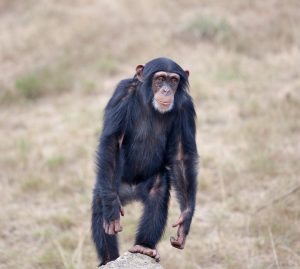From ridge tops to ravines: landscape drivers of chimpanzee ranging patterns
Posted on: 9 November 2019
Preprint posted on 7 October 2019
Article now published in Animal Behaviour at http://dx.doi.org/10.1016/j.anbehav.2020.02.016
Chimpanzees use advanced spatial cognition to plan least-cost routes
Posted on:
Preprint posted on 7 October 2019
Paths of least resistance: Green and colleagues find that chimpanzees remember and prefer to use the most energy-efficient routes, and not necessarily the shortest, to move around in their natural habitat.
Selected by Ashrifia Adomako-AnkomahCategories: animal behavior and cognition, zoology
Background

Several features of a landscape can affect how much energy it takes to use a specific route. Going up a slope, walking on a soft surface such as sand, and walking through obstacles on the ground such as snow, tall grass, or low-hanging tree branches can all increase the amount of energy it takes to move around. Researchers have found that humans consider many of these factors when planning their routes, and often choose paths that are easier to navigate and therefore have lower energy costs. However, not much is known about whether or how these factors affect how non-human primates choose their routes. In two recent preprints, Green and colleagues analyze the factors that influence how chimpanzees choose which routes to use in their natural habitat.
Interesting findings
In one preprint, Green et al. tracked the movements of 14 chimpanzees over 14 months in a national park in Rwanda, Central Africa. On each day of tracking, they randomly selected one male chimpanzee from the first group that they encountered and followed it throughout the day, recording its position by Global Positioning System technology. They chose to follow male chimpanzees because males usually travel longer distances than females. The researchers examined whether the chimpanzees more often used trails made by humans, paths made by chimpanzees, or mountain ridges, all of which would be energy-efficient choices. Compared to a linear route through the forest, the chimpanzees showed a strong preference for man-made trails, a significant preference for routes made by chimpanzees, and a slight preference for mountain ridges. The chimpanzees therefore appeared to intentionally avoid the road less travelled in favor of well-used routes.
Green et al. state that there are several benefits to the travel patterns that they observed:
- Chimpanzees are likely to expend less energy when they use man-made or chimpanzee trails because the constant use of these paths causes them to have smoother surfaces with fewer obstacles. Additionally, man-made trails might have bridges that help the chimpanzees cross streams and rivers.
- The chimpanzees might have to make an extra effort to use routes on ridges if these routes are far away from their usual paths. They might decide not to do this if the alternative is not significantly less energy efficient.
- Because chimpanzee family groups often break apart and reunite, reusing routes might make it easier for members of the same family to find each other.
This preprint showed that chimpanzees appear to remember which routes are easiest to navigate. But how do they accomplish this?
In the second preprint, Green et al. used a model of chimpanzee movement that incorporates information about slopes, ridges, streams, vegetation, and human trails to find the best fit for the tracking data that they obtained from the 14 chimpanzees. They also incorporated estimates of how much energy a chimpanzee would expend when using each route.
The researchers found that the models that best fit their data assumed that the chimpanzees were able to learn the layout of their landscape, remember the location of obstacles, and plan their routes based on this prior knowledge. This ability is called spatial cognition, and is well-documented in humans. Spatial cognition is more likely to benefit animals like chimpanzees, which live in areas with a variable landscape and which spend a significant amount of time on the move, searching for food and other resources. Green and colleagues conclude that incorporating information on energy cost would help improve models of animal movement.
What I like about this preprint
This preprint reminds me that literally and figuratively, the shortest path is not always the best option.
Follow-up question
The authors state that there are some risks associated with using human paths, such as meeting humans. Do the authors predict that the chimpanzees will be able to identify when the risks of using these paths outweigh the benefits?
Reference
Tommasi, L. & Laeng, B. (2012). Psychology of Spatial Cognition. WIREs Cognitive Science 3, 565–580. doi: 10.1002/wcs.1198.
Sign up to customise the site to your preferences and to receive alerts
Register hereAlso in the animal behavior and cognition category:
Blue appendages and temperature acclimation increase survival during acute heat stress in the upside-down jellyfish, Cassiopea xamachana
Maitri Manjunath
Experience-dependent plasticity of a highly specific olfactory circuit in Drosophila melanogaster
T. W. Schwanitz
Behavioral screening of conserved RNA-binding proteins reveals CEY-1/YBX RNA-binding protein dysfunction leads to impairments in memory and cognition
Chee Kiang Ewe
Also in the zoology category:
Blue appendages and temperature acclimation increase survival during acute heat stress in the upside-down jellyfish, Cassiopea xamachana
Maitri Manjunath
How the liver contributes to stomach warming in the endothermic white shark Carcharodon carcharias
Sarah Young-Veenstra
Unlocking the secrets of kangaroo locomotor energetics: Postural adaptations underpin increased tendon stress in hopping kangaroos
EMB EMB_Liv et al.
preLists in the animal behavior and cognition category:
9th International Symposium on the Biology of Vertebrate Sex Determination
This preList contains preprints discussed during the 9th International Symposium on the Biology of Vertebrate Sex Determination. This conference was held in Kona, Hawaii from April 17th to 21st 2023.
| List by | Martin Estermann |
Bats
A list of preprints dealing with the ecology, evolution and behavior of bats
| List by | Baheerathan Murugavel |
FENS 2020
A collection of preprints presented during the virtual meeting of the Federation of European Neuroscience Societies (FENS) in 2020
| List by | Ana Dorrego-Rivas |











 (No Ratings Yet)
(No Ratings Yet)